Climate and Ag in the news
-

The New York Times noted in a story earlier this week that sometime later this summer, a United jet will fly from Los Angeles to San Francisco using biofuel from farm waste and oils derived from animal fats. This is a first step by the airlines to convert more of their fleet to lower-carbon alternatives than…
-

As expected, the tropical Atlantic Ocean has been quiet this hurricane season so far, due primarily to the influence of wind shear associated with the El Nino that is present in the Eastern Pacific Ocean. On the other hand, the warm ocean water in the Eastern Pacific Ocean is contributing to an active season there.…
-

Georgia’s Board of Natural Resources approved a new drought plan last week, according to Walter C. Jones of Morris News Service in this article from OnlineAthens.com. The drought plan was modified from an earlier drought plan that caused farmers and agribusinesses some concerns in the exceptional 2007-2009 drought in north Georgia. The new plan is…
-

Heat waves have been in the news lately, not only in the western US but also in Europe. One of the stories discusses a possible new high temperature record for the state of Washington, which is currently under strong high pressure and very warm temperatures while we cool off a bit in the Southeast. Cliff…
Posted in: Climate and Ag in the news -

Florida International University announced a new Spanish-language web site for hurricane preparedness this week. This web site provides information on preparation, taking care of pets in severe weather, protecting your property, and evacuation procedures as well as historical information on past hurricanes. You can find the site at https://huracanes.fiu.edu/.
-

How do we know about past climates and prehistoric civilizations? Since we don’t have instrumental records or written histories, we have to use clues from the environment to help us decipher what the past was really like. “Proxy data” are used to try to find a link between something that we can observe, like tree…
-

WABE, NPR’s radio station in Atlanta, produced a story today about projected urbanization changes in the Southeast. At current growth rates, we could see a nearly continuous string of urban areas stretching from southwest of Atlanta all the way to Raleigh NC and northeast. How would the increase in urbanization affect local climate conditions? The…